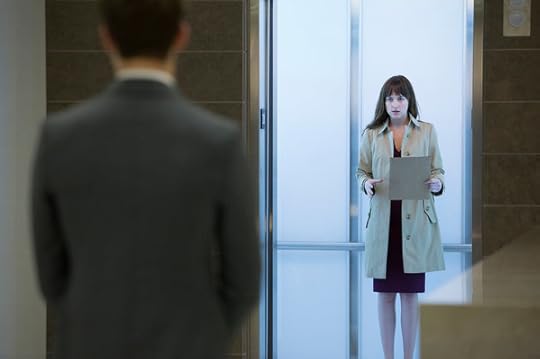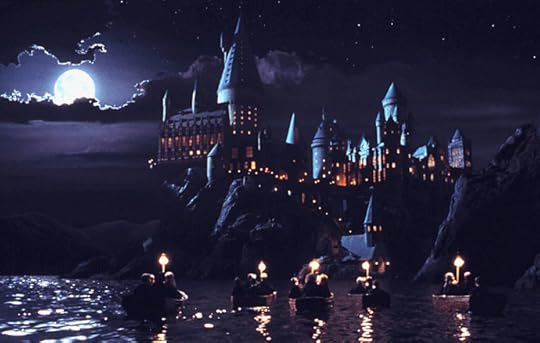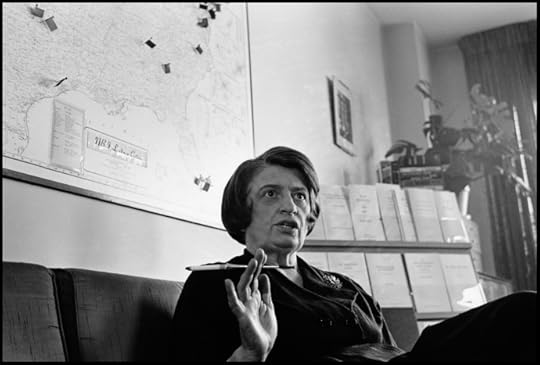Maria Tatar's Blog, page 9
February 17, 2015
Fifty Shades of Grey as a Fairy Tale?
From the New York Times:
Indeed, when Ms. Taylor-Johnson read “Fifty Shades” for the first time, she did not see it as “mommy porn,” as some have called it, nor as an unlikely story full of clunky prose bogged down by a strangely chirpy narrator prone to referring to her “inner goddess,” as some reviewers have complained. Instead, she read it as “a deep, dark, romantic adult fairy tale,” she said. “I thought, I haven’t seen anything cinematically like what I was reading for a long time, if at all,” Ms. Taylor-Johnson continued. “It felt like a very deep romance and a love story the likes of which felt quite unique.”
http://www.nytimes.com/2015/02/15/mov...
Marina Warner links Fifty Shades of Grey to the Bluebeard story, but a version of the story in which revenge “eludes the protagonist . . . and the female author chooses to let Bluebeard have his way.”
In Secrets beyond the Door, a book I wrote many years ago about the story of Bluebeard and his wives, I focused on the charismatic appeal of the Bluebeard figure, a man who is wealthy, mysterious, sexually seductive . . . controlling and violent. The Bluebeard story “begins on the outside–in the realm of the familiar, common, and quotidian–and moves to the inside–the exotic, dangerous, passionate, and barbaric.” What I discovered in the course of my research is that Bluebeard is one of those stories that will not go away, it ferociously repeats itself, as if it were entirely new. Fifty Shades of Grey is the latest cultural inflection, and now I have my work cut out for me: reading the trilogy and watching the movie, then making a contribution to a shelter for victims of domestic abuse.
February 7, 2015
True History of Jewish Wizards at Hogwarts
Underestimating Laura Ingalls Wilder
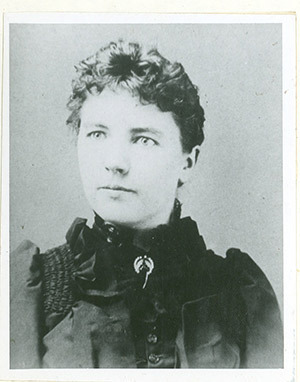 In Laura Ingalls Wilder’s On the Banks of Plum Creek, Pa heads to town promising to return by nightfall, but a terrible storm blows through, and hefinds himself trapped in a snow bank for three days. To survive, he eats the candy he brought for the girls’ Christmas stockings.
In Laura Ingalls Wilder’s On the Banks of Plum Creek, Pa heads to town promising to return by nightfall, but a terrible storm blows through, and hefinds himself trapped in a snow bank for three days. To survive, he eats the candy he brought for the girls’ Christmas stockings.
It’s a tale of pluck and miscalculation not lost on the publishers of Pioneer Girl, Wilder’s new annotated autobiography. Last November, they found themselves trapped in a snowbank of preorders for the book, which they won’t dig their way out of until March. They didn’t have to eat the Christmas peppermints, but they did leave Wilder fans crying in their homespun handkerchiefs when the book didn’t arrive in time for the holidays.
The size of the initial print run might seem ridiculously small, considering that Wilder’s Little House books have sold more than 60 million copies. “But you have to understand—this is an academic book,” says Koupal. Pre-Pioneer Girl, the press’s best-seller was the children’s book Tatanka and the Lakota People: A Creation Story, which sold around 15,000 copies.*
“We felt we were taking a huge risk even to do [15,000].”
February 1, 2015
“You are a children’s literature fanatic.”
Who knew?
https://www.youtube.com/watch?v=lOdZ1pajS-I
Lena Dunham on Eloise:
“I think so many young women were obsessed with Eloise’s unruly magic,” she said. “She’s just such a remarkably independent, vanity-free, complex little girl, and as a little girl you don’t see that many representations of yourself beyond a good little child with pigtails. So it was meaningful.”
“The tattoo is what caused Hilary Knight to make contact with me,” said the actress/director/author/producer. Having heard there was an up-and-coming TV star with a tattoo of his work, “he sent me a letter, which is very old-school, and some signed books, which, obviously, for an Eloise fanatic is a huge deal.”
Dunham said that after striking up a friendship with the 88-year-old New Yorker, she “very quickly realized that he had a very unique story that needed to be told and that (her friend Matt Wolf, who directed the film) was the person to tell it.”
“It’s Me, Hilary” was accepted into the Sundance festival’s documentary-shorts category and will air on HBO.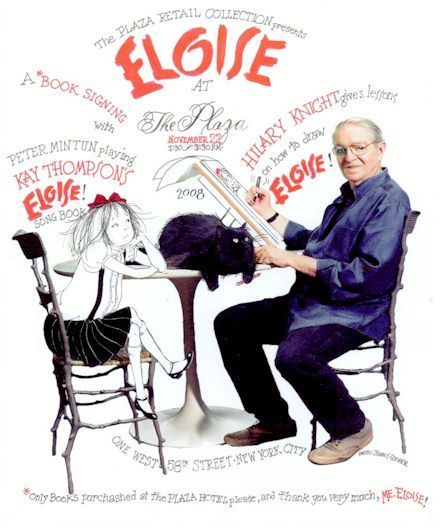
January 23, 2015
Aimee Bender Reviews Marina Warner’s ONCE UPON A TIME
http://www.nytimes.com/2015/01/25/books/…
This is the challenge and excitement of writing anything comprehensive about such stories: More than any other genre, fairy tales travel and transform — they are rewritten, remade, recollected and retold. Warner has been studying them for decades, across continents and millenniums, and she tracks their evolution with relish.
The chapters are well organized, covering historical documentation, feminism, psychoanalysis, the impact of illustration, film, and more, though at times the subheadings feel arbitrary or narrow, unable to contain the roaming feel of Warner’s prose. A writer who describes how stories “migrate on soft feet, for borders are invisible to them, no matter how ferociously they are policed by cultural purists” has some of that same quality herself, and besides the wealth of information here, the strongest readerly pleasures are her associations with and riffs on the many, many things fairy tales touch.
A good day for fairy tales!
January 15, 2015
Three Little Pigs Now Off Limits?
 Jim Naughtie – whose writer wife Eleanor Updale is in talks with Oxford University Press (OUP) over an educational book series – said: ‘I’ve got a letter here that was sent out by OUP to an author doing something for young people.
Jim Naughtie – whose writer wife Eleanor Updale is in talks with Oxford University Press (OUP) over an educational book series – said: ‘I’ve got a letter here that was sent out by OUP to an author doing something for young people.
‘Among the things prohibited in the text that was commissioned by OUP was the following: Pigs plus sausages, or anything else which could be perceived as pork.
‘Now, if a respectable publisher, tied to an academic institution, is saying you’ve got to write a book in which you cannot mention pigs because some people might be offended, it’s just ludicrous. It is just a joke.’
Muslim Labour MP Khalid Mahmood said: ‘I absolutely agree. That’s absolute utter nonsense. And when people go too far, that brings the whole discussion into disrepute.’
Read more: http://www.dailymail.co.uk/news/article-2908910/Oxford-University-Press-bans-sausages-pigs-children-s-books-avoid-offending-Jews-Muslims.html#ixzz3OtwKNeuW
Follow us: @MailOnline on Twitter | DailyMail on Facebook
A spokesman for OUP said: “OUP’s commitment to its mission of academic and educational excellence is absolute.
“Our materials are sold in nearly 200 countries, and as such, and without compromising our commitment in any way, we encourage some authors of educational materials respectfully to consider cultural differences and sensitivities.”
January 10, 2015
“Into the Woods” Reviewed by Jerry Griswold
Last week, Sunse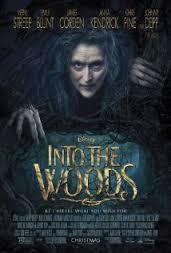 t Boulevard’s largest billboard featured Meryl Streep at her scariest, and the oversize image inspired me to see Into the Woods as soon as possible. Imagine the shock of realizing that the reviewers had been way too kind.
t Boulevard’s largest billboard featured Meryl Streep at her scariest, and the oversize image inspired me to see Into the Woods as soon as possible. Imagine the shock of realizing that the reviewers had been way too kind.
http://www.newyorker.com/culture/cultura…
http://www.nytimes.com/2014/12/25/mov...
Vanity Fair had what seemed like a more honest assessment.
http://www.vanityfair.com/vf-hollywoo...
While the film respectably keeps some of the original show’s darkness, it skimps on the Witch’s character arc and so Streep simply vanishes toward the end of the film, not getting to deliver the Witch’s true gut punch of a song. I also don’t like the way she’s costumed—her glam second-act makeover has her looking like Madame Morrible’s blue sister, not the sudden seductress she’s supposed to be.
But these are quibbles next to the film’s harder to define central problem, which is that there simply is so little heat or passion to be found anywhere. Marshall has m ade a technically assured film that does the difficult work of taking Sondheim’s tricky music out of its original context. But it rarely feels imaginative. It’s cautious and reserved, cramped where the stage show, when done right (and, honestly, even when not done right), is expansive. After all this is a show that’s all about life, the experience of being alive, the lessons and trials and journeys and setbacks. All that elemental, universal stuff, shrewdly molded into tweaks of familiar fairy tales. It’s an ingenious show, and a profound one. But in film form, in this particular film form anyway, the story is small and inert, it’s too specifically about these people, when really the show is supposed to be about all of us. That problem is owed partly to the film’s rushed pacing and too-stringent edits, but there’s something more ineffable going wrong here, too. There’s no genuine heart beating at the center of the film. It’s a dutiful but perfunctory adaptation, sapped of vim and spirit.
Jerry Griswold has weighed in on the film, and I’m thrilled to present his work here.
Who is Disney’s “Into the Woods” For?
By Jerry Griswold
For their musical “Into the Woods,” which premiered at San Diego’s Old Globe Theater in 1986, Stephen Sondheim and James Lapine seemed to draw primarily on two then popular books about fairy tales. Bruno Bettelheim’s “The Uses of Enchantment” took these childhood stories seriously, analyzed and linked them in a psychological manner, and won a National Book Award in 1976. Ann Sexton’s “Transformations” (1971), on the other hand, was a collection of comic poems where she retold the fairy tales in adult and cynical ways. Her poem about “Cinderella,” for example, ends on this note of sarcasm:
Cinderella and the prince
lived, they say, happily ever after,
like two dolls in a museum case
never bothered by diapers or dust,
never arguing over the timing of an egg,
never telling the same story twice,
never getting a middle-aged spread,
their darling smiles pasted on for eternity.
Regular Bobbsey Twins.
That story.
When I saw the musical on stage in the 1980s, I liked the first act but not the second. Critics agreed. Something changed after the intermission. Act I is a wonderfully clever mash-up that links the fairy tales (primarily “Little Red Riding Hood,” “Rapunzel,” “Jack and the Beanstalk,” and “Cinderella”) and behind which you can sometimes detect knowing nods to Bettelheim. Act II, however, is “dark” and meant to undeceive those who believe in “happy endings.” We learn that loved ones often die, cruelty is rampant, orphans abound, people cheat in their marriages, princes can be jerks, and so forth. In this you can hear Sexton’s voice.
Disney’s new film version of “Into the Woods,” directed by Rob Marshall, is largely faithful to the eclectic musical by Sondheim and Lapine. Moreover, this Whitman Sampler of fairy tales is brought to you by a sizeable ensemble–including Meryl Streep, Emily Blunt, Johnny Depp, Anna Kendrick, Tracey Ullman, Christine Baranski, James Corden, and Chris Pine. All over the place, the movie’s very fecundity suggests how difficult it is to identify the intended audience for what might be described as a galloping musical fantasy crossover comedy-drama film.
It is rated PG. But kids watching the film in my local theater seemed dampened by the mopey second half. They laughed at the cleverness of the first act, as well known storybook characters crossed into each other’s stories and interacted; still, it should be said that when it comes to clever fairy-tale mash-ups, “Shrek” does it better. But as for the second act’s dreary sharing of existential facts (regarding mortality, adultery, etc.), all in the name of growing-up and becoming undeceived, well, kids aren’t big on Weltschmerz. And that’s because, as James Barrie complained in “Peter Pan,” the young are gay and heartless.
But, alas, making kids’ stories “dark” seems de rigeur these days. While the original fairy tales are violent and contain the supernatural, they weren’t meant to be categorized as “Gothic”; it’s only in recent years that they have been Twilight-ed and pitched to brooding teens. But it’s not just fairy tales that have been “darkened.” Consider the difference between Disney’s original “Alice in Wonderland” and Tim Burton’s creepy version. Or Spike Jonze’s film “Where the Wild Things Are” which took Maurice Sendak’s beloved picture book and turned it not into a children’s film but “a film about childhood” by replaying Jonze’s own feelings about growing up as a child of divorce and resulting in a movie full of misunderstandings, hot tears, anger, home-wrecking, and injured recriminations. (I once saw a teacher leading a line of fourth graders down the sidewalk to a theater to see Jonze’s film and, like the Catcher in the Rye, wanted to jump out of the car and save them from what they thought was going to be a film version of their favorite book.)
So, who is Disney’s “Into the Woods” for? Maybe it’s not fair to take kids, who will be lured by the clever first half and then bludgeoned by maturity in the second. Maybe it’s for cynical grown-ups and teen goths—in other words, those partial to moody decrescendo when innocence is “darkened.” But as I sat in the theater, it became evident that the real enthusiasts for this film are fans of musicals, those who loved L’Miz, theater majors, those who memorized the songs when their high school put on “Into the Woods” and now had the chance to sing along—in short, those who have yet to reexamine their initial enthusiasm for the television series “Glee.”
* * *
Jerry Griswold is the author of Feeling Like a Kid: Childhood and Children’s Literature.
January 9, 2015
Fringe Benefits of the Dark Side
Sharma Shields writes about her diagnosis of multiple sclerosis in the NYT and how she manages bedtime reading with her children.
http://opinionator.blogs.nytimes.com/...
At night, I read fairy tales to the kids — “Hansel and Gretel,” “Snow-White and Rose-Red” — stories in which unsentimental children are abandoned in a brutal world, left to fend for themselves. My son briefly develops a fear of wolves; my daughter becomes terrified of skeletons. I want to tell them: People are scarier than wolves; we all have a skeleton inside of us. But I know better than to say such things, and maybe they need to feel what they feel and fear what they fear. I hold them close and kiss their heads and tell them I’ll always keep them safe.
Readers’ comments seem evenly divided between those expressing shock and horror at the idea of reading Grimm to young children and those validating the choice. Over the years, I’ve had many conversations with students about their encounters with scary stories, and most of them (granted, it’s a self-selecting group of voracious readers) emphasized their eagerness to explore the dark side. I’ve always believed that children, even at a very young age, know their limits, and if a story is too frightening and overwhelms them in some way, they will either fall asleep or walk away. If you read to your child on a regular basis, it’s easy to navigate this terrain with conversations about each story that help you instinctively calibrate what is appropriate for bedtime reading. Reading fairy tales may expose children to the dark side, but it also introduces them to survival skills, teaching them to use their heads to outsmart predators. Shoving the witch into the oven may be a bridge too far, but no reason to be reverent about the words on the page, especially for the younger crowd.
January 7, 2015
Marah Gubar on ANNIE
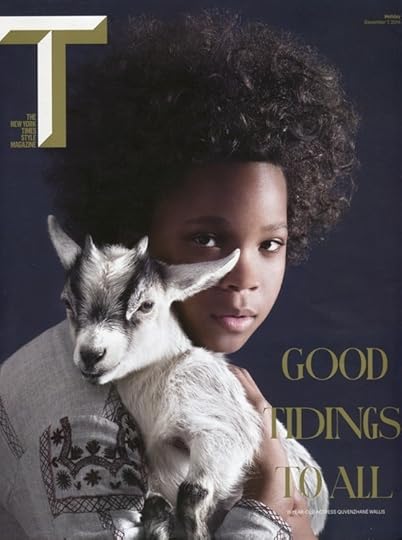 http://www.publicbooks.org/multigenre/the-teflon-kid-how-annie-enables-apathy-about-inequality
http://www.publicbooks.org/multigenre/the-teflon-kid-how-annie-enables-apathy-about-inequality
That an African American child can now be presented to the public as an all-American icon of innocence feels like a victory. After all, children growing up during the Great Depression—when Annie achieved her mythic status—inhabited a society in which purity and beauty were both coded white, as Toni Morrison makes clear in her insightful novel The Bluest Eye (1970). Morrison’s African American child protagonists struggle to maintain a sense of self-worth at a time when magazines, movies, children’s books, dolls, and even candy wrappers proclaimed that white children had cornered the market on cuteness. In this context, Wallis’s donning of Annie’s famous red dress constitutes a hopeful sign that our culture is growing less wedded to whiteness as an aesthetic ideal.
December 21, 2014
Ayn Rand Reviews Children’s Movies
http://www.newyorker.com/humor/daily-...
“Charlotte’s Web”
A farmer allows sentimental drawings by a bug to prevail over economic necessity and refuses to value his prize pig, Wilbur, by processing and selling him on the open market. Presumably, the pig still dies eventually, only without profiting his owners. The farmer’s daughter, Fern, learns nothing except how to become an unsuccessful farmer. There is a rat in this movie. I quite liked the rat. He knew how to extract value from his environment. —Two stars.
What’s next? Kierkegaard on Goodnight Moon, Shakespeare on The Fault in Our Stars, and Freud on “Rumpelstiltskin”? Oh wait, Freud did weigh in on that story.
Maria Tatar's Blog
- Maria Tatar's profile
- 316 followers


